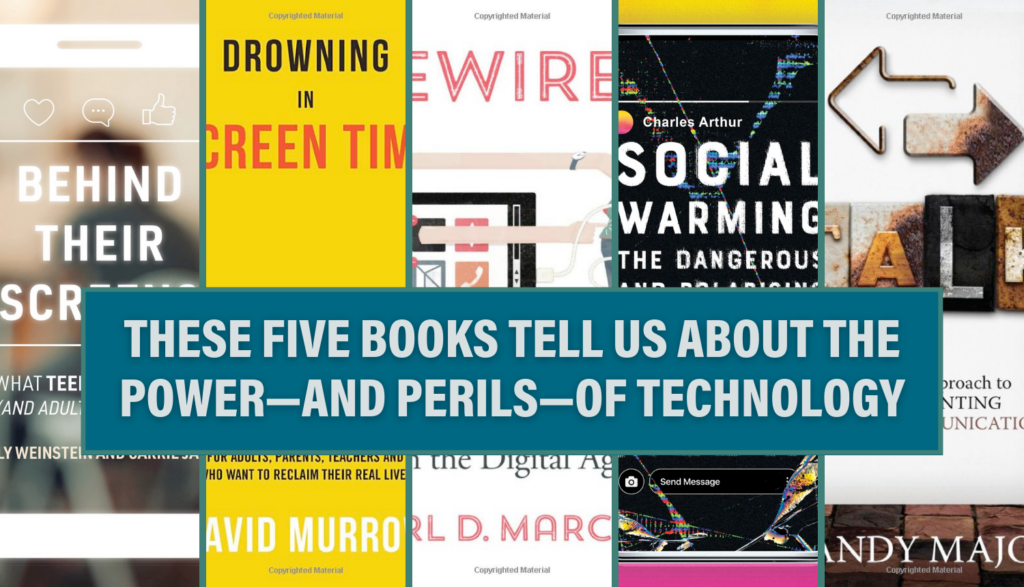You could write a book about it.
We often say such things when we’re talking about big topics. We sometimes say that very phrase here at our sprawling Plugged In headquarters. Spider-Man: Across the Spider-Verse? Yep, someone could write a book about all the themes in play in that movie, given its multiverse setup and musings about free will and fate. The Flash? Well, that already comes with books. Comic books, that is.
But when you hit a subject such as technology—well, one book simply can’t do it justice. You could write a library on the ways that technology and our screens are changing us and changing the world. And, given how fast technology changes, we’d have to keep adding wings.
The Plugged In staff can’t read every book that deals with technology, of course. But we try to keep as … well, plugged in to our changing culture as possible. And with that in mind, we did want to share what we’ve learned in five hot-off-the-presses books that deal with the intersection of screens and self.

BEHIND THEIR SCREENS: WHAT TEENS ARE FACING (AND ADULTS ARE MISSING)
by Emily Weinstein and Carrie James
While many books (including some in this blog) focus on how tech, social media and screens are impacting society at large, authors Emily Weinstein and Carrie James take a slightly more targeted tack. In Behind Their Screens, the authors have amassed reams of research designed to take in the views of teens and adolescent users.
Weinstein and James shape their book as a vehicle to inform parents of what teens wish their moms and dads knew. They give readers a kid’s-eye-view of social media’s connections, its community importance and its problems—including addiction, sexting, bullying and cancel culture.
Some of the results are quite eye opening. One thing that stuck out to me was the fact that kids are very aware of the problems that come with always having a screen in their hand. And they worry about the effects, too.
“The app TikTok runs my life,” one teen is quoted in the book. “I can sit there for hours on end just scrolling through this app. … I can’t even count how many times I have fallen asleep on TikTok. It has taken over my life.”
And kids are heedful of how social media is cleverly designed to hijack someone’s focus.Another teen opined: “The most tricky part about growing up with social media is how dangerous and addictive it is. People are always glued to their phones, so am I and I hate that.”
One of the great points that came out of the authors’ research was that teens desire strong relationships. That includes their relationships at home. But the pull of the screen is tough to fight. And, unfortunately, that pull impacts parents, too. The authors note: “Notably, adolescent kids whose parents’ attention is constantly diverted by tech describe their parents as less warm, loving, responsive, and comforting than do kids whose parents are less digitally distracted.”
So, we’re back to the standard parental fallback of bellowing a collective turn it off! Right? But here’s the rub.
“I think it would be nice if adults realized that our entire social life is linked to social media,” a young respondent said. “It isn’t like when they were kids, where your social times were mostly during school. Nowadays, if you aren’t on social media a lot, you won’t have as many friends. It’s all linked to it.”
To a young person, that means (paraphrasing another respondent) that you can’t just shut your phone off and be done with it.Steering clear of social media or texts means that teens might lose friends and their social support structure.
So how do parents find the balance and reach a healthy solution? Well … there aren’t many directly applicable remedies doled out by Weinstein and James. And some of the things they do suggest can feel a bit clinical. But the fact is, social media apps, smartphones and games—with all their problems—aren’t going away. There is a dire need for communication and understanding between parents and their kids. And this book helps parents hear both sides of the conversation a bit better.
(Reviewed by Bob Hoose)

DROWNING IN SCREEN TIME: A LIFELINE FOR ADULTS, PARENTS, TEACHERS AND MINISTERS WHO WANT TO RECLAIM THEIR REAL LIVES
by David Murrow
David Murrow knows more than most about screen time. According to his bio, the television producer has spent “the last four decades working in the screen-addiction business,” honing his TV specials, educational programs and commercials in such a way that viewers wouldn’t dare change the channel. Ironically, he swore he’d never grow “addicted” to that form of entertainment, as his own father and so many others had. But with the internet, and by the late 2000s, Murrow stumbled into full-blown screen addiction. “I was trading away real life for screen life, just as my father had.”
It’s not that Murrow thinks that screens or online activities are uniformly horrible. He teaches pastors and teachers how to improve their messages for an online audience, after all. He knows how critical and even beneficial technology can be. But he’s aware of how corrosive and damaging screens can be, as well—both how we use them and what we consume on them. And, as fitting for a man steeped in ministry and Christian culture, Murrow’s book begins with a series of parables.
For instance, one depicts a man drawn out to sea—and his doom, by riptides, illustrating how sneakily technology can lead us away from solid ground. Another illustration talks about a guy filling a bowl already full of ping-pong balls with water until some balls float right out of the bowl: The balls represent the real duties we must focus on; the water is how our screen time usurps every available extra minute we have and then some.
The book is filled with sobering stats and studies (some of which Plugged In has also reported) about how much we use screens and how damaging they can be. But he doesn’t just tell readers that screens are bad. He offers clues on how to get our own screen time (and our children’s usage) under control. For example, he suggests that readers might consider a digital detox, and he cautions them to be wary of “danger times.” Murrow writes, “For many people, that’s right when they get home (from work or school), because they associate relaxation with screen time.”
He also reminds us that the most perilous stuff about screen time goes beyond the time we spend with them: it’s about what we use them to access. When I interviewed Murrow (you can hear that interview July 13 episode of the Plugged In Show), he talked about the sobering reality of how many Christian men access pornography online.
Most of the titles we’ve listed here come from the secular side of the publishing coin. Drowning in Screen Time comes from a Christian publishing house and features a Christian perspective. And David Murrow knows what he’s talking about.
(Reviewed by Paul Asay)

REWIRED: PROTECTING YOUR BRAIN IN THE DIGITAL AGE
by Carl D. Marci
Not too long ago, if you wanted to learn something, you’d have to go to the library and hope they had a book answering your question. If you wanted to talk to a long-distance relative, you’d have to wait weeks to send and receive a letter. But in the modern age, technology is at our fingertips, allowing us to accomplish these and even more daunting feats almost instantaneously. But can there be too much of a good thing? According to the hundreds of studies referenced in Carl D. Marci’s Rewired, the answer is a resounding yes.
Despite the boons that come with the digital age, research is showing that the incessant presence of technology (and in particular, smartphones) is having serious consequences on our malleable brains. Drawing on this research, Marci warns us that the digital age is shortening our attention span and self-control capabilities, increasing our feelings of loneliness and depression, decreasing our emotional capacity for empathy and worsening our memory—and that’s all just the start.
Broken into three parts, Marci’s first section sets the stage to explain how we, as a culture, arrived at where we are today, explaining how smartphones and social media heavily tap into and overwrite the biological social bonds our brains crave. He also explores an evolutionary perspective of the development of the brain and how it’s designed for community.
His second section then focuses on how technology rewires our brain throughout a variety of age groups—from newborn to adult. This divide primarily shows the potentially irreversible impact of prolonged technology use on our growing brains. (In terms of content concerns, note that a small insert describes the impact that the prevalence of online pornography has had on male arousal.) Finally, after many chapters filled with ominous forebodings about the damage technology can do to our brains, Rewired ends with a section describing how we can maintain a healthy tech-life balance.
Rewired may initially seem like its claims are a bit far-fetched, but readers will certainly understand where Marci’s concern comes from after they read through the dozens upon dozens of references to academic papers, studies and experiments Marci puts forth in his book. Our consumption of technology shapes us in myriad ways—even when it’s as innocent as TV background noise! By the end of the book, readers will come away not only with a greater understanding of the dangerous ways technology can rewire us but also arms them with action steps to mitigate such rewiring.
(Reviewed by Kennedy Unthank)

SOCIAL WARMING: THE DANGEROUS AND POLARISING EFFECTS OF SOCIAL MEDIA
by Charles Arthur
Where the documentary film The Social Dilemma opened our eyes as to what was happening with social media, Social Warming tells us how it happened. Charles Arthur lays out the history of how nearly every social media platform has placed the almighty dollar above the well-being of its users (and the greater global community). It feels personal. And it should. Because much like a sexual predator, social media groomed us before taking advantage.
“Nobody meant for this to happen,” Arthur sympathizes. “The purpose [of social media] was to help us find friends, to stay in touch with our families, to cultivate new interests, make the world more ‘open’ and ‘connected’.” Unfortunately, social media outlets have slowly but surely raised the global social temperature. As Arthur explains, they’ve destabilized democracies, incited the killing of innocent people and the displacement of entire populations, polarized societies and undermined politics.
We’ve known for quite some time that social media is a problem. The different platforms use algorithms to get us to scroll and keep on scrolling indefinitely. They affect our brains in ways much like drugs do. And the companies that created these platforms know this, too. Yet, they do nothing to fix it. Because even though we know that social media is negatively affecting us, we continue to use it.
We use them to connect with loved ones, to share funny videos, to get updates on news stories, to learn about political candidates. And over time, social media companies (or rather, the algorithms that make them rich) have learned how to keep us engaged. Unfortunately, it’s not through funny videos. Seditious statements, provocative titles and angry trolls spur the masses on. The algorithms amplify outrage because that’s what makes things go viral.
Social media platforms have affected voting results through strategic ad placements. They’ve incited riots in underdeveloped countries through lack of moderation. And their uniquely designed algorithms have time and time again driven users towards more and more extreme content. Because when we engage with any content, those AI programs are trained to believe we will want to see even more content like that, regardless of whether or not we agree with it.
The solution, Arthur suggests, isn’t to shut social media down. After all, not everything about these platforms is bad. Rather, we need to implement regulations that will scale down social media platforms to a more manageable size; employ methods of moderation that prevent harm better and faster than algorithms can amplify it; turn social media into platforms that unite us. As Arthur puts it, “The extent of social warming demonstrates that the time has come to reshape and redesign these broken tools we have come to rely on.”
Readers should note that Social Warming won’t appeal to everyone. There are a few profanities sprinkled throughout (including five uses of the f-word). And some of Arthur’s examples of social media misuse come off distinctly partisan.
(Reviewed by Emily Tsiao)

TALK: A PRACTICAL APPROACH TO CYBERPARENTING AND OPEN COMMUNICATION
by Mandy Majors
In a world where it seems like we’re constantly communicating via screens, the fine art of just talking can sometimes feel, ironically, like it’s fallen on hard times. That’s especially true when it comes to braving awkward conversations with our kids about the many threats they face online.
It’s easy to assume that our kids are doing fine. But as Mandy Majors relates in her book Talk: A Practical Approach to Cyberparenting and Open Communication, that may not be the case at all. In fact, she challenges us to face our complacency in the face of this threat.
Talk is an interesting book, structurally, because it begins with a long narrative of the events that propelled Majors to pull her proverbial head out of the sand. One day, her daughter, who was 9 at the time, “blindsided” Majors with a very explicit question about sex. Turns out, one of her daughter’s friends had talked with Majors’ daughter about something pornographic she’d encountered. And now this little girl wanted help understanding what it all meant.
Majors talks a lot about how this catalytic event opened her eyes. She decided to take a much more intentional approach to guiding her kids through the landmines of cyberculture. “My daughter’s innocent question turned my world upside down and opened my eyes to the far-reaching impact of the digital world,” she writes. “Her question was a wake-up call for me. At that moment, all of my naïve beliefs about parenting changed forever. That’s when this crazy cyberparenting journey began.”
Majors details her own journey of feeling initially overwhelmed, then angry, then finally shifting into a mode in which she sought to establish safeguards to protect her children even as she strived to let them know that she was committed to open and honest conversation with them about these tough subjects. That translates into her book, where she encourages us to focus on relationship: with our kids, with our spouses and with other friends on a similar journey with their children.
She writes, “The most important thing we can do to pave a path of open communication with our children is to become their safe place. … They need to know they can trust us with their problems and questions, and that we’ll keep their confidences.”
Talk offers a challenging, encouraging and relatable blend of confessional storytelling (Majors isn’t shy about chronicling her own parenting miscues and failures), challenging exhortation from a biblical perspective and concrete counsel about the hard topics that our families and our children may face. These include issues such as sex, masturbation, LGBT and transgender questions, pornography, masturbation, suicide, addiction and the threat of mass shootings. She also offers insights on how to navigate issues such as when to get a phone, setting boundaries and using tech filters, modesty and dress and the potential threats of sleepovers, among other things.
As a parent of one tween and two teens, Mandy Majors’ messages about the importance of building relationship with our kids really resonated with me. She strikes a nice balance between grace and truth, and she recognize the need for both in the ways that we seek to enter into an ongoing conversation with our kids about these hugely important issues.
(Reviewed by Adam Holz)











2 Responses
-With all the talk of technology and AI, here’s a quote that came to my mind:
In the words of Dr. Ian Malcolm from “Jurassic Park”: your scientists were so preoccupied with whether or not they could, they didn’t stop to think if they should.
-Good one!